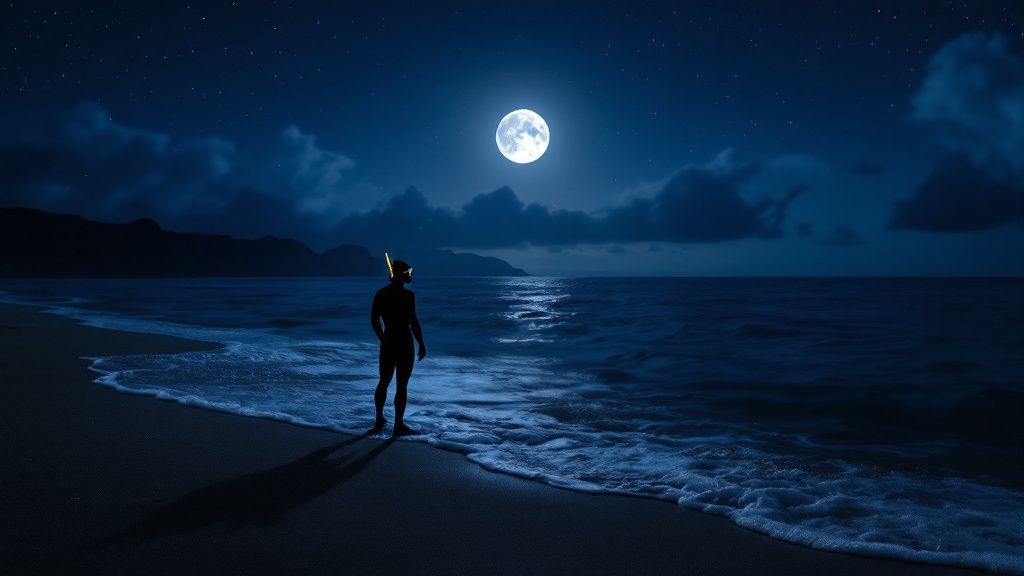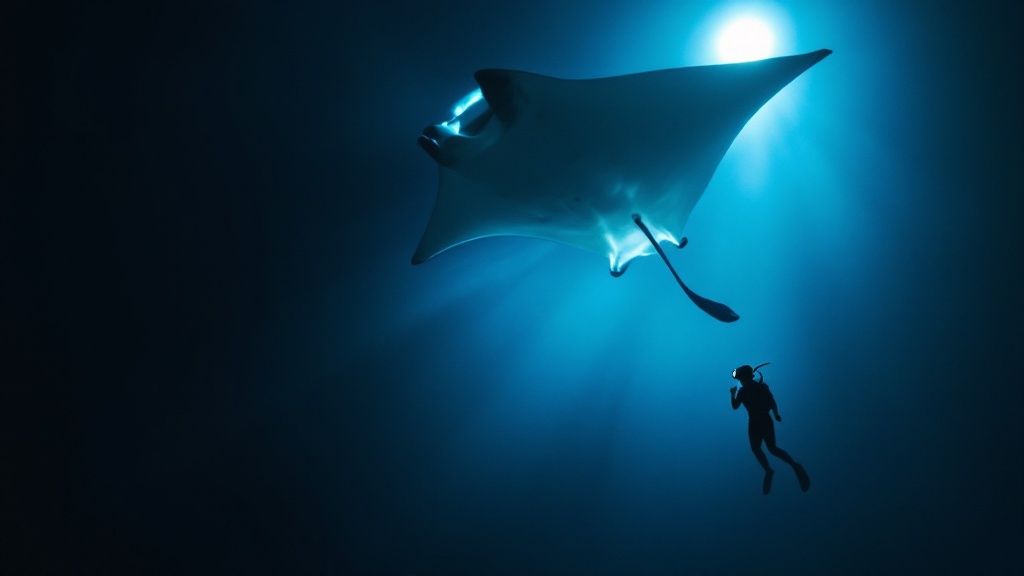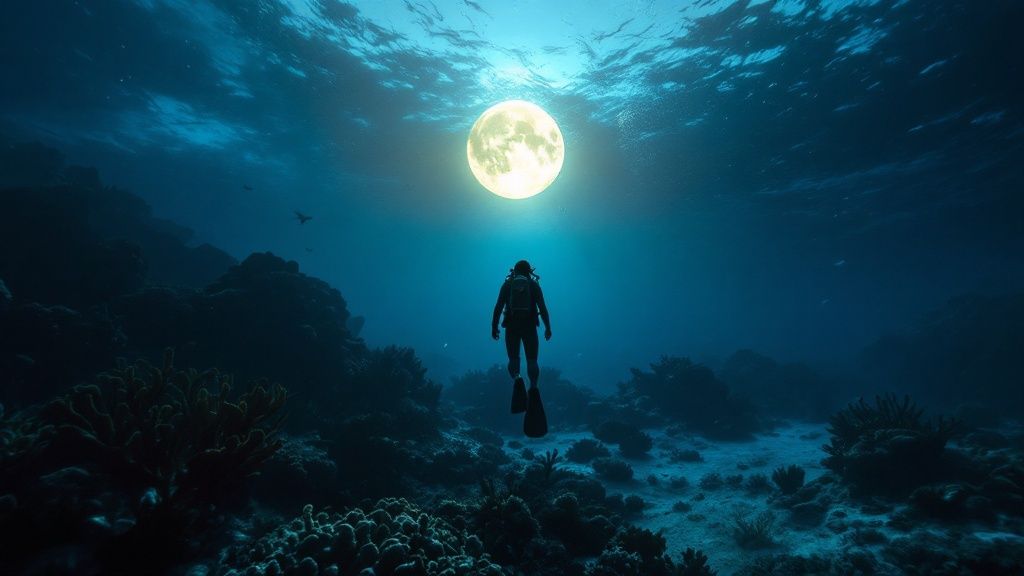Experience night snorkeling with manta rays kona
- Byron
- Mar 31
- 11 min read
The Magic of Manta Ray Night Snorkeling in Kona

As twilight paints the Kona coastline, a hidden world comes alive beneath the waves. The setting sun signals the start of a mesmerizing ballet: the nightly gathering of manta rays. This unique experience has become a must-do for visitors, offering an intimate look at these gentle giants in their natural habitat.
Kona's unique oceanographic conditions create the perfect stage for this nightly spectacle. Nutrient-rich currents flow along the coast, providing a feast of plankton, the manta ray's main food source. Attracted by the lights used by snorkel tour operators, the plankton rise closer to the surface, drawing the manta rays in for an incredible feeding display.
This feeding behavior is what truly sets Kona's manta ray night snorkeling apart. Unlike daytime encounters or experiences in other locations, here you witness the mantas' graceful underwater acrobatics as they feast. Looping and barrel-rolling, they seem to dance in the light, creating an unforgettable spectacle for lucky onlookers. Imagine a manta ray performing a backflip as it scoops up plankton – a truly awe-inspiring display.
The Rise in Popularity of Manta Ray Night Snorkeling
This extraordinary experience has seen a surge in popularity, especially after changes in Hawaii's wildlife interaction laws. Following 2020 legislation restricting dolphin interactions, many visitors have sought out eco-friendly alternatives, leading to increased demand for manta ray night snorkeling. Over 80,000 people now participate annually, drawn by the chance to witness these gentle giants feeding under the Hawaiian starlight. Find more detailed statistics here. This growing interest reflects a desire for ethical and sustainable wildlife encounters. You can also explore our blog post sitemap for more fascinating content.
Cultural Significance and Sustainable Practices
Known as ‘hahalua’ in Hawaiian tradition, manta rays symbolize wisdom and grace. Experiencing these creatures in their natural environment connects visitors with the rich cultural heritage of the island. Many reputable tour operators, such as Kona Honu Divers, Manta Ray Night Snorkel Hawaii, and Kona Snorkel Trips, prioritize sustainable practices, supporting research and conservation efforts. Consider also Captain Cook Snorkeling Tours for a memorable adventure. This responsible approach to tourism helps ensure that future generations can also experience the magic of Kona's manta ray night snorkeling.
Prime Locations for Unforgettable Manta Ray Encounters

Not all manta ray viewing locations are created equal. Along the Kona coast, two spots stand out: Manta Village and Manta Heaven. These locations offer consistent opportunities for night snorkeling with manta rays, each with its own distinct charm.
Manta Village: A Shallow-Water Spectacle
Manta Village, nestled in Keauhou Bay, is known for its shallow, calm waters. This makes it a perfect spot for beginners and families. The bay's sandy bottom reflects the lights used to attract plankton, creating a brilliantly lit viewing area. This enhances the manta ray spectacle, providing an illuminated stage for their graceful feeding dances.
Kona Honu Divers offers tours to this location. For more options, check out their sitemap.
Manta Heaven: A Deeper Dive into the Blue
Manta Heaven, at Garden Eel Cove, offers a deeper water experience. While suitable for confident snorkelers, the darker environment adds an element of mystery. The open ocean setting can also mean larger swells, adding a touch of adventure to the experience.
Manta Ray Night Snorkel Hawaii and Kona Snorkel Trips are two popular tour operators that frequent Manta Heaven.
Choosing Your Ideal Manta Ray Encounter
To help you choose the right location for your snorkeling adventure, take a look at this comparison table:
Manta Ray Viewing Locations in Kona: Comparison of the main manta ray night snorkeling locations along the Kona coast
Location | Known For | Average Depth | Best For | Typical Group Size |
|---|---|---|---|---|
Manta Village (Keauhou Bay) | Shallow, calm waters, bright viewing area | 10-15 feet | Beginners, families | Varies by tour operator |
Manta Heaven (Garden Eel Cove) | Deeper water, open ocean setting | 20-30 feet | Confident snorkelers | Varies by tour operator |
This table highlights the key differences between the two locations, allowing you to select the spot that best suits your experience level and preferences.
The Science Behind the Spectacle
Both locations offer ideal conditions for manta ray viewing due to the abundance of plankton. The underwater topography and currents at both Manta Village and Manta Heaven create a feeding ground that attracts mantas night after night.
Captain Cook Snorkeling Tours is another great option to explore. The Kona Coast is famous for reliable manta ray sightings. Data collected by Manta Ray Advocates from 2009-2014 confirmed consistent encounters, helping researchers study manta ray behavior.
For those interested in other water activities, check out Florida Keys Water Activities. Whether you choose Manta Village or Manta Heaven, a night snorkeling with manta rays in Kona is sure to be an unforgettable experience.
Selecting Your Perfect Manta Ray Tour Experience

With so many tour operators offering night snorkeling with manta rays in Kona, finding the right one can be a challenge. This is a once-in-a-lifetime experience, so making the best choice is essential for an unforgettable adventure. This guide will help you navigate the options and select the perfect tour for you, focusing on key factors that set operators apart.
Conservation and Ethical Practices
When choosing a manta ray tour, prioritize operators committed to conservation. Look for companies actively involved in sustainable tourism practices and research. Some operators even contribute to manta ray identification projects, providing valuable data for ongoing studies. This dedication to research and conservation reflects a genuine commitment to protecting these gentle giants.
Choosing an ethical operator ensures a responsible and enriching experience for you and a positive impact on the manta ray population.
Safety Protocols and Vessel Types
Safety is paramount when choosing a manta ray tour. Always inquire about an operator's safety certifications, emergency procedures, and the experience of their guides.
The type of vessel also matters. Smaller boats offer a more intimate setting, while larger vessels may offer amenities like restrooms and changing areas. Consider your personal preferences and what level of comfort you desire.
Tour Formats and Group Size
Tour formats and group sizes vary considerably. Some operators specialize in small, personalized tours, while others cater to larger groups. A smaller group allows for a more intimate interaction with the manta rays and a more tailored experience with your guide. Larger groups can create a more social atmosphere. Consider what kind of experience you’re looking for when making your decision.
Many tours include additional perks like snacks, drinks, or photography packages. Asking specific questions beforehand will help you avoid surprises and ensure the tour aligns with your expectations.
You might be interested in: Our blog category sitemap for more information on planning your trip.
Key Questions to Ask and Red Flags
Before booking, asking the right questions can reveal valuable insights. Inquire about the operator's experience, their approach to wildlife interactions, and their cancellation policies.
Be cautious of operators who guarantee manta ray sightings – wildlife is unpredictable. Also, be wary of operators who seem to prioritize profit over conservation. These are potential red flags that could indicate a less reputable operation.
Unique Experiences and Personalization
Some tour operators provide unique experiences to enhance your adventure. These might include marine biologist guides or underwater photography assistance. If you have specific interests, like underwater photography or marine biology, seek out specialized tours that cater to them. Families with young children may want to choose operators who cater to families.
Finding a tour tailored to your interests can significantly enrich your night snorkeling with manta rays Kona experience.
To help you choose, we've compiled a comparison table of some popular tour operators:
Top Manta Ray Tour Operators in Kona Comparison of leading manta ray snorkeling tour providers and their offerings
Tour Company | Group Size | Duration | Includes Gear | Extra Features | Price Range |
|---|---|---|---|---|---|
Kona Honu Divers | Varies | Varies | Yes | Night Dive Options | $100 - $200 |
Manta Ray Night Snorkel Hawaii | Small | ~2 hours | Yes | Photography Packages | $150 - $250 |
Kona Snorkel Trips | Medium | ~1.5 hours | Yes | Snacks and Drinks | $120 - $200 |
Captain Cook Snorkeling Tours | Varies | Varies | Yes | Private Charters | $150 - $300 |
Note: Prices and offerings may vary. Check with each operator for the most up-to-date information.
This table provides a quick overview of various tour operators, allowing you to compare group sizes, durations, included gear, extra features, and price ranges. It’s a valuable resource for finding the tour that best fits your needs and budget.
Kona Honu Divers offers a diverse range of options. Consider Manta Ray Night Snorkel Hawaii and Kona Snorkel Trips for their reputable services. Captain Cook Snorkeling Tours is another operator worth checking out. Researching different operators lets you compare offerings and choose the perfect fit for your unforgettable manta ray adventure. Remember, a reputable operator is crucial for an enjoyable and ethical experience.
Your Night in the Water: The Complete Manta Experience
A night snorkeling adventure with manta rays in Kona is truly a unique experience. From the moment you arrive on the shore to the magical encounter beneath the waves, this immersive walkthrough details what awaits you on this incredible journey.
From Shore to Sea: Preparing for the Encounter
Your adventure begins with a pre-departure briefing. Experienced guides, often certified lifeguards, will cover essential safety procedures and proper snorkeling techniques. They'll also share fascinating insights into the biology and behavior of manta rays. This educational session prepares you for a respectful and enriching encounter.
Next, you'll be fitted with all the necessary equipment, including a wetsuit, mask, snorkel, and fins. Some operators, like Manta Ray Night Snorkel Hawaii, offer rentals of specialized equipment like underwater cameras.
A short boat trip then transports you to the designated viewing site. The anticipation builds as you approach areas like Manta Village or Manta Heaven, known for their consistent manta ray activity.
The Manta Ballet: Lights, Plankton, and Graceful Giants
Upon arrival, guides deploy specialized light systems. These lights attract plankton, the manta ray's main food source. As the plankton gather near the surface, drawn to the illuminated water, the manta rays follow, creating a mesmerizing spectacle.
Now, the moment you've been waiting for: entering the water. Guides will instruct you on proper positioning techniques, often using a large, lighted float for snorkelers to hold onto. This minimizes disturbance to the mantas and maximizes viewing opportunities while maintaining a safe and respectful distance.
A Sensory Symphony: Immersion in the Nighttime Ocean
Imagine floating in the darkness, the gentle waves lapping against your wetsuit. The world beyond your light source fades into the inky black, creating a surreal atmosphere. Then, a shadow emerges – a manta ray, its vast wings gliding effortlessly through the water.
This is the magic of night snorkeling with manta rays. It's a sensory feast. You’ll feel the cool water, hear the subtle sounds of the ocean, and witness the breathtaking sight of these magnificent creatures up close.
Respectful Observation: Etiquette for Sustainable Encounters
Respect for these gentle giants is paramount. Guides emphasize proper etiquette around marine wildlife, reminding you to avoid touching the manta rays and minimizing disruptive movements. This responsible approach ensures a positive experience and contributes to sustainable tourism practices. Learn more in our article about our other blog posts.
Following these guidelines enriches your personal experience and contributes to the long-term health of the manta ray population and their environment. Operators like Kona Honu Divers and Kona Snorkel Trips champion these practices. Captain Cook Snorkeling Tours is another reputable option offering a variety of tours. Choosing a conscientious operator helps preserve this magical and unique experience.
Perfect Timing: Maximizing Your Manta Ray Encounter

Forget the usual advice about "peak seasons." Planning the perfect Kona manta ray night snorkeling adventure requires a more thoughtful approach. This section helps you understand the nuances of timing to truly maximize your encounter.
Beyond the Calendar: Factors Influencing Manta Ray Sightings
Manta rays in Kona aren't migratory like some marine life. They're more like local celebrities, consistently present, making Kona a popular destination for manta ray viewing. Thankfully, they're fairly consistent residents. While there's no defined "manta ray season," they appear on over 80% of nights when conditions allow. Divers have reported seeing over 36 manta rays on exceptional nights! Learn more here.
This consistency makes viewing opportunities excellent. However, several factors influence sightings. These include moon phases, currents, and water clarity.
A full moon, for instance, can reduce the effectiveness of plankton-attracting lights, affecting visibility. Ocean currents also play a key role in plankton distribution, influencing where manta rays feed. Even within Kona, certain locations might be more active than others depending on these currents. Water clarity, affected by weather and rainfall, is also crucial for spotting these gentle giants.
Seasonal Considerations: More Than Just Mantas
While manta ray sightings are consistent, the time of year affects other parts of your night snorkeling experience. Summer offers beautiful sunsets before entering the water, enhancing the evening's magic. However, this is peak tourist season, meaning larger groups and potentially crowded waters.
Spring and fall offer a more tranquil experience, with fewer visitors and the potential for more intimate encounters. For information about tours and booking, visit our sitemap. When choosing your travel dates, consider whether you prefer vibrant sunsets or quieter encounters.
Strategic Scheduling for Manta Ray Encounters
If your itinerary is flexible, strategic scheduling can boost your chances of a successful encounter. Many tour operators offer flexible booking policies that allow rescheduling based on conditions. Some examples include Kona Honu Divers, Manta Ray Night Snorkel Hawaii, and Kona Snorkel Trips. Captain Cook Snorkeling Tours is another great option to consider. Booking your tour early in your stay allows for rescheduling if the weather is unfavorable on your initial date.
Realistic Expectations: Embracing the Unpredictability of Wildlife
Remember, wildlife encounters are inherently unpredictable. While Kona's manta rays are remarkably consistent, there are no guarantees. Embrace this natural variability and appreciate the opportunity to observe these creatures in their environment. Even a single manta ray sighting can be a truly memorable experience. By understanding the factors that influence their behavior and being flexible, you’ll maximize your chances of an unforgettable encounter.
Essential Preparation For Your Manta Ray Adventure
The difference between a good manta ray night snorkel in Kona and a truly great one often comes down to preparation. This guide will help you get physically, mentally, and equipment-ready for your manta ray encounter.
Building Water Confidence
If you're new to snorkeling or haven't been in the ocean much, practicing beforehand can greatly improve your experience. Even trying out your snorkeling gear in a pool can help you get used to breathing through a snorkel and using fins. This can ease any pre-trip nerves about the open ocean, especially at night.
Dressing For The Occasion: In And Out Of The Water
Hawaiian ocean temperatures can be surprisingly cool after sunset. While the air stays warm, the water requires the right attire. Most tour operators provide wetsuits, which are highly recommended. A wetsuit not only keeps you warm but also adds buoyancy, making floating easier and more comfortable.
After your snorkel, you'll want to warm up quickly. Pack quick-dry clothing and a towel so you can change out of your wetsuit comfortably.
Essential Gear Checklist: Don't Forget These Items!
Besides standard snorkeling equipment, a few key items can significantly enhance your experience. Anti-fog solution for your mask is crucial. A foggy mask can obstruct your view of the manta rays. Also, if you're prone to motion sickness, consider medication or motion sickness wristbands.
Wetsuit (usually provided by tour operators)
Mask and snorkel
Fins
Anti-fog solution
Motion sickness remedies (if needed)
Towel
Quick-dry clothing
Addressing Nighttime Water Concerns
Many first-time snorkelers are apprehensive about being in the ocean at night. Reputable tour operators, like Manta Ray Night Snorkel Hawaii, prioritize safety. Experienced guides, often certified lifeguards, are present throughout the excursion. They use powerful lights to attract plankton and manta rays, while also illuminating the water for better visibility.
Capturing The Magic: Photography Tips
A GoPro or waterproof camera is perfect for capturing your manta ray encounter. Remember that flash photography can disturb the manta rays and is often discouraged. Focus on enjoying the moment and capturing the magic responsibly.
Communicating Your Needs
Talking to your tour operator beforehand is vital. Share any specific needs or concerns, such as requiring a life vest, physical limitations, or being a first-time snorkeler. Operators like Kona Honu Divers, Manta Ray Night Snorkel Hawaii, and Kona Snorkel Trips are known for their communication and customer service. Don't forget to check out Captain Cook Snorkeling Tours too.
By following these tips, you can make your manta ray night snorkel in Kona a truly unforgettable experience. Book your Manta Ray Night Snorkel Kona Hawaii Tours today!
Comments